|
The first two films Agnès Godard shot as a camerawoman are among those
most highly respected for the quality of their images: The Belly of an
Architect (1987) directed by Peter Greenaway, and Wim Wenders's Wings of
Desire (1987). Even earlier, as a camera assistant, Agnès Godard had
already worked on two other films by Wenders: The State of Things (1982) and
Paris, Texas (1984). And more recently, she has worked as director of
photography for Agnès Varda, Peter Handke and Claire Denis. RR: As I mentioned in my letter, Wim Wenders stated in an interview that you didn't entirely agree as to the way in which the scene with the dying motorcycle man should be filmed, and that in your view, the camera movement in this scene wasn't entirely justified. AG: I was astonished when you told me that since I had no recollection of it at all. I was so astonished that I tried to think back to what might have been in question, and in fact, it's true and it's connected to several different issues. To begin with, it was only my second film as camera operator. So I was a bit intimidated by it all. Secondly, it was at the start of the shooting, and I don't think I had realized at that point to what degree Wim knew what the camera saw. Something about the camera movement seemed a bit risky to me and scared me, because I wasn't quite able to see in it as clear and perfectly logical ("Cartesian") a purpose, though that of course was not the nature of the film, which is poetic. But that's what had frightened me. It was difficult to carry out technically because of the equipment. The camera was on a dolly on tracks, and in order to keep it low enough, that is at the eye level of people seated on the ground, it had to be mounted on what we call a "swan neck" - a brace which enables you to keep the camera in a very low position. The camera moved, it descended, from a rather high to a low position, and I had to do a balancing act. It was quite uncomfortable and I was afraid of not executing the movement in a fluid way. And also there [in Berlin], I couldn't follow what was being said, I didn't understand [the language] well enough to grasp what was really happening. I think the technical worries got to me most... It was a cause of some anxiety for me.
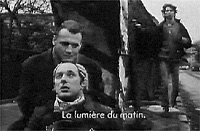
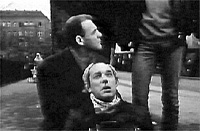 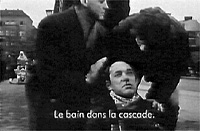
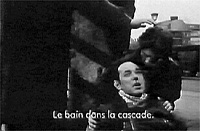
RR: Do you see those camera movements as open to other interpretations as well? AG: I never had a chance to discuss these things with Wim during the shooting; obviously, that would have been impossible. My understanding - and this came afterwards - is that the camera had to move in order not to be dead before the character. That's what I felt, in the rhythm, like a heartbeat that might stop at any moment. But we don't see it stop, there's no melodrama here. When I saw the film, I also loved the cut to the following shot: of the angel filmed in a slightly high angle tracking shot as he walks on the bridge. Life went on with that walking, which ends when a train passes, heading elsewhere. Death was part of life.
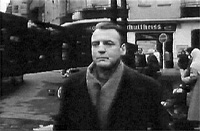
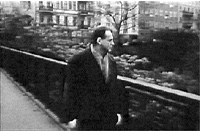 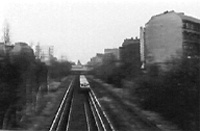
RR: When I asked him why the camera moved back and forth, he proposed two explanations: 1) that in some way, those camera movements expressed the pain Damiel experienced; and 2) "I thought that going left to right sort of showed more what Damiel was actually doing, in the way that he's sort of taking over the dying man, so to speak. In a strange way, it was in that camera movement." AG: Yes, I see. It was somewhat in that sense that I mentioned heartbeats. But like something throbbing. For example, I have on several occasions seen people in psychiatric hospitals, and when their pain is throbbing, sometimes they shift their weight from one foot to another. It's a little like that. And with that pain, it was not an altogether normal heartbeat. Something was ending. And in fact, cutting to Damiel walking on the bridge was in a sense accepting that [the dying man] has passed away, perhaps... But we don't see it end. Life goes on, through Damiel, who knew perhaps before anyone else that it was going to end. That's why we don't need to see it end. RR: Wenders also said that originally, the shot which began on the bridge was supposed to continue without any cutting, but that it was physically impossible since the camera-car couldn't make the turn as tightly as would have been necessary. AG: Yes. The shot depended on the route of the car and the movement of the camera. The camera was mounted on the front of the car which had to be driven at high speed. At the place where the wounded man was lying, the road was damaged - the car couldn't really turn - and the maximum breadth of the pan was insufficient. The shot couldn't be done the way Wim wanted it at the end of this ride on the bridge. He must have felt the need to find some other way of enriching what was to follow. RR: If the camera had not been moved back and forth, from left to right, would the shot have been too static? AG: Yes, I think so. I think it would almost have been a pleonasm with the text. But being in motion, for whatever reason, something magical happens, it enables the words to breathe and we accept the duration. It's very strange. Because the words are after all quite poetic, even though they are almost everyday words, and it makes them breathe, it brings them to life while evoking the notion of duration. And Wim alone had foreseen that. And for me, it's also expressive of fragility: one fine day, those words can vanish, without our giving them a thought; at any given second, it can all stop. For me, it also expressed something of that kind. During the shooting, I didn't enjoy [the spoken words] as fully as I do now because it was in German and I had trouble understanding it. I should add that when Bruno [Ganz] spoke while being filmed, there was so much music in it that even though I couldn't understand everything he said, I was carried away. But I didn't have any insight into its meaning. So I had some worries that Wim must have sensed. It isn't entirely wrong to say that I didn't agree since I asked myself: "Is it certain that this is the right way to do the shot?" RR: When I showed this scene to my students, some of them said that the back and forth movement of the camera was an oscillation between life and death, and that even the fact that the action takes place at the end of a bridge is significant in that respect. Does that strike you as entirely mistaken? AG: No, I don't think it's mistaken. As a matter of fact, the richness of many of the shots and of the "mise en images" in general in this film, springs from the fact that you can sometimes find an unlimited number of explanations or images of that kind, because what is said and the manner in which it is filmed are so perfectly suited to one another. That's truly beautiful. Granted, you can also arrive at some far fetched interpretations, but basically, what really counts is that so many things be suggested that each person can find in it his or her own explanation, and that's magnificent. That means that the implement called cinema is there in all its plenitude, and it's wonderful that each of us can find his or her own explanation. That's what makes images come to life. For me, that's the magic of cinema: that from something lifeless and impalpable, there is a moment in which sensation and emotion are created, and that it is possible to make images live beyond their texture. In this film, I think that that happens to a fascinating degree. RR: Was the path of the camera movements in this shot slightly curved? AG: No, it wasn't curved, it was a traveling in a straight line. The effects man was really extraordinary. He also knew exactly what was in the frame of the camera. But Wim was there and he was the conductor... For him, there is an intellectual investigation in play, since he knows very well what meaning this kind of thing can produce. Often, and sometimes for extended periods, he asked himself questions. But at a certain point, I think a certain intuition comes and he trusts it. It's quite strong. In that respect, he has a special contact with the space seen through a lens. RR: Did you need to do more than one take for that shot? AG: Yes, we did several takes. I'm not sure how many. Probably about five or six. RR: But all done in about the same way? AG: Yes... I wanted to add something about the camera movements and that kind of intuition. The exceptional quality of the "mise en images" in this film is also due to camera movements that are sometimes quite sophisticated, without ever appearing to be so. It was never the camera that set feelings in motion. It's more subtle than that... And I was afraid that in reframing the shot, in going after the young man, we were imposing - by the very fact that we went looking for him, that we were reframing the angel and the dying man - that we were pulling the strings of the story. It seemed preferable to me that it be the chain of events by themselves, that Damiel was someone who, by nature, was always there at the right time, and that that was the chain of events. RR: Another piece of information Wim Wenders gave me: he said that when he realized that he couldn't continue the shot on the bridge, that he stood before the two actors and looked at them through a viewfinder, moving to the right and to the left in search of the right place to position the camera. And in this way, he conceived the idea... AG: Yes, a viewfinder, that's wonderful. He must have been trying out different positions. Yes, that doesn't surprise me. (Laughter). That goes to show that Wim does a kind of preparatory work which reflects a concern for precision. But he is also capable of always remaining open to what is going on at the very moment... And what you are telling me now is the proof of that. I think it's brilliant. RR: In the library scene, what interests me particularly is the fact that instead of constructing the point of view figure in the classic fashion - first showing the eyes that are looking, then cutting to what those eyes are seeing - here we begin with the point of view shots and then the person through whose eyes we are seeing enters his own point of view. This choice of combining in a single shot what the character sees and the character who is seeing, is extraordinary. Not many directors do that. Yes. [...] I remember that during the first rehearsal of that scene, at the moment of transition from the woman-angel to the entrance of the two men into the visual field, I discovered something magical [in the shot]. And for the first time (I had not been a camera woman for very long), I had the impression that this required looking in a different way through the camera. In other words, going along with the meaning of the action... It was no longer a matter of technique, but rather a kind of poetry in play. I don't know how to explain it. For me, all of a sudden, an understanding that every movement of the camera had a meaning and that it meant something other than itself. This was an incredible sensation and it frightened me because I felt charged with a very important obligation: to do it well because it was extremely important in this film. I felt I understood everything Wim worried about when making this film and the questions he asked himself concerning the "mise en images". [...]
Paris, 27 January 1994 [1]This interview was published in French and under the title "Faire vivre les images" in (Pré)publications 142 (February 1994), pp. 42-56. The present translation is my own.
|